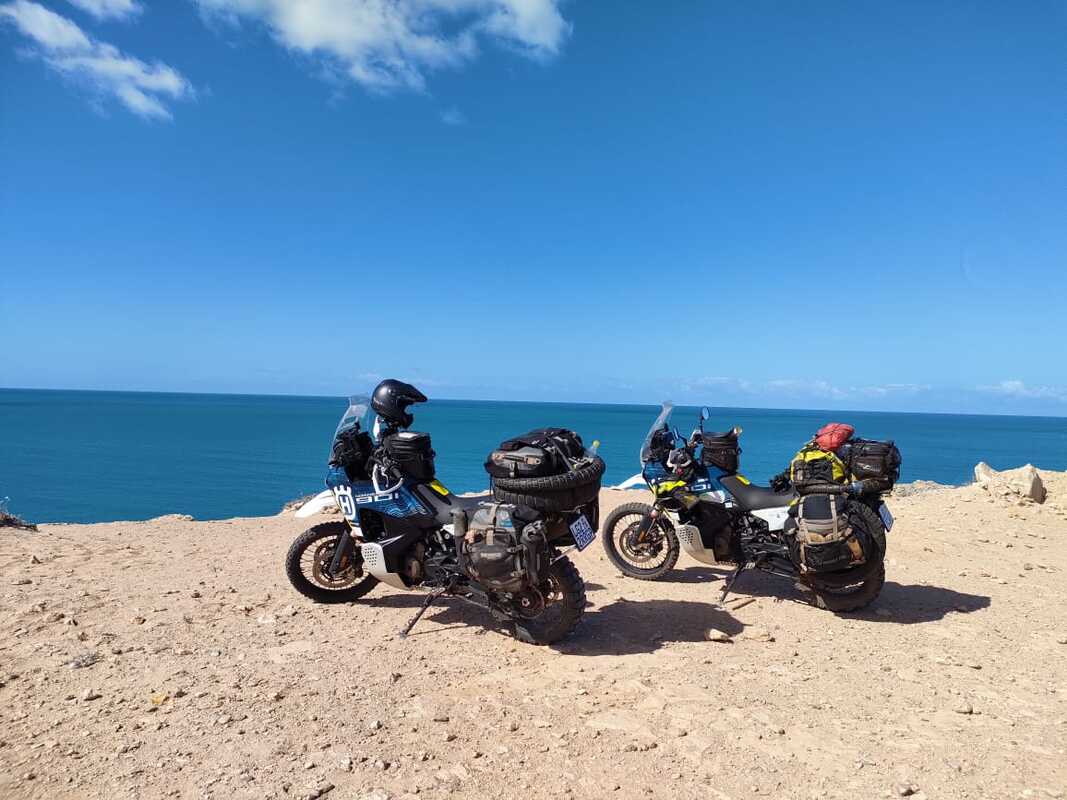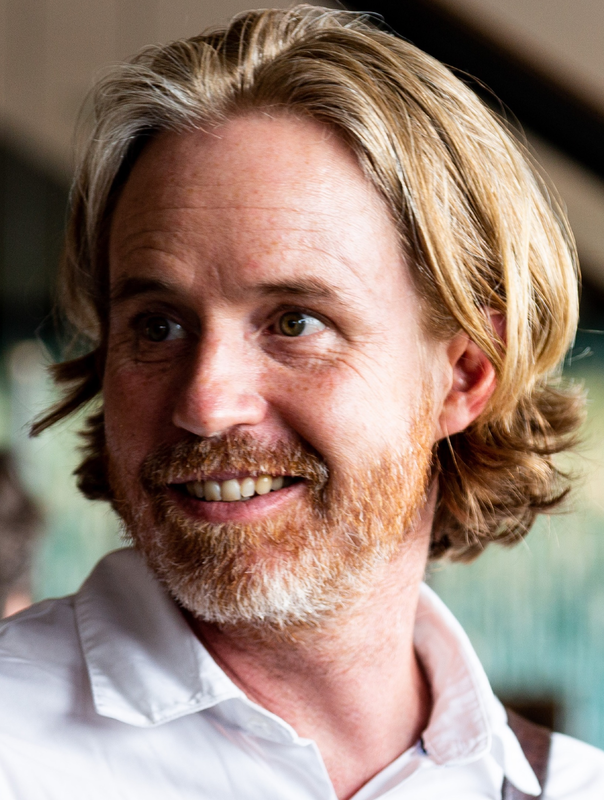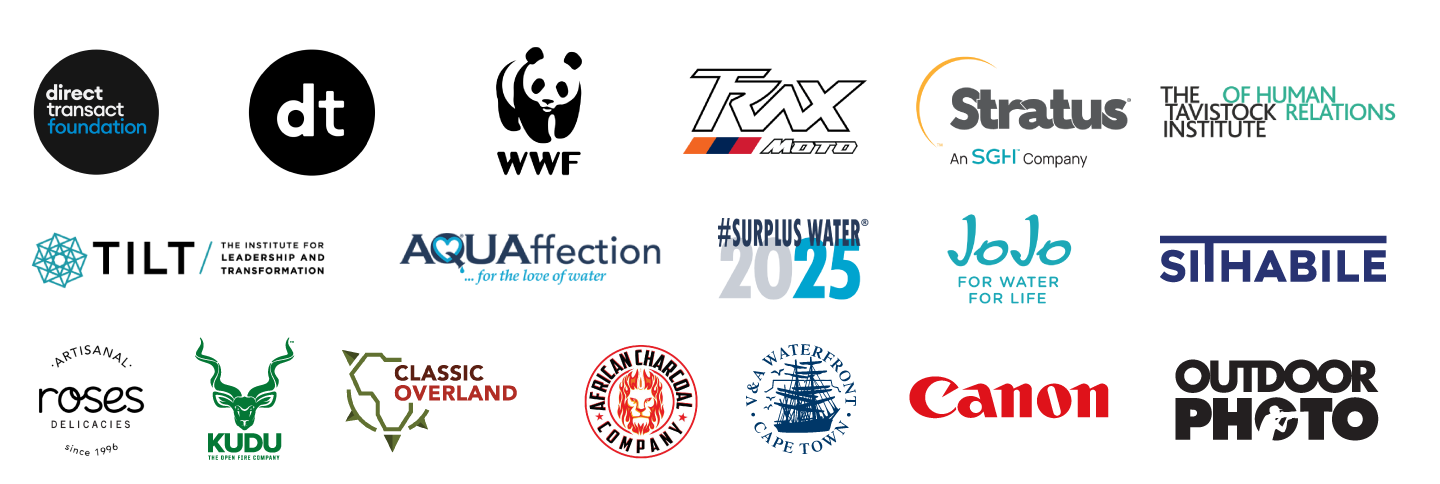|
(English Translation Below)
Dag 71: Dakhla na Laayoune Die wind is koud en dit word ál later lig. Ons spring weg met ons wind-brekers - dink ons sal hulle later uittrek as die son opkom, maar die byt in die lug laat los nie. Dis duidelik dat ons ál Noorder in die rigting van die winter beweeg. Die pad kronkel deur rotsformasies. Pyl dan reguit Noord. Wieg swenkend heen en weer deur lang draaie. Kom versigtig tot teenaan die hoë erosie-wal waar Afrika stop en die see begin, net om ons te wys. Swenk dan weer land-in om vir ons die loerende wit duine aan die gesigseinder te wys. Heeltyd speel die wind saam. Nie so venynig soos gister nie, maar beslis koeler. Druk ons dié kant toe en daai kant toe soos wat die pad ons rondwys. Vyfhonderd kilometer van woestyn-vistas tot in Laayoune. Net voor die dorp 'n weermag stop-punt. Daar is by elke dorp in en uit só 'n punt. Meeste kere waai hulle net vir mens. Soms stop hulle jou, skandeer jou paspoort, laat jou ry. Vriendelik. Dié keer stop hulle ons. Een ou stap weg met die paspoorte. Die ander ou is nuuskierig: Waar kom julle vandaan? Suid-Afrika?! Maar wat is julle nasionaliteit? Suid-Afrikaans?! Maar julle is dan...hy vat aan sy neus en oë omdat dit al vel is wat uitsteek onder ons motorfietsgewaad... wit? Ja sê ons, daar is baie wit mense in Suid-Afrika. Hy glimlag skepties en wens ons voorspoed toe met ons reis. Laayoune was die hoofstad van die destydse Spaanse Sahara voordat Morocco die streek geannekseer het. Dis langs 'n oase gebou, maar deesdae is hier 'n ontsoutings-aanleg om water aan die stad te voorsien. Ons loop die strate in om iets ete te kry. Dit voel soos Europa. Eetplekkies en koffiewinkels oral. Die stoele tipies gerangskik dat almal straat toe kyk. Breë sypaadjies. Winkelvensters. Maar anders as Europa en Suid-Afrika is dit omtrent uitsluitlik slegs mans wat by die restaurante en koffieplekke sit. 'n Bietjie verder, by die fontein in die middedorp, waar die kinders speel, sien ons vroue geklee in hijabs sit en staan en gesels. Jonges op rolskaatse seil in die straat af. Ander staan in groepies na hulle fone en kyk. Oorfone in die ore. Hoodies oor die koppe. Sentraal- en Wes-Afrika voel nou ver. Day 71: Dakhla to Laayoune The wind is cold and the mornings stay dark until later and later. We start with our windbreakers - thinking we'll take them off later when the sun rises, but the bite in the air doesn't let up. It's clear that we're moving ever Northward towards the winter. The road winds through rock formations. Aims straight North. Then gently sways to and fro through long curves. It carefully brings us right up to the high erosion wall where Africa stops and the sea begins, just to show us. Then swings inland again to show us the white dunes on the horizon. All the while, the wind plays along. Not as mean as yesterday, but definitely cooler. Pushing us this way and that as the road guides us along. Five hundred kilometres of desert vistas to Laayoune. Just before the town, a military checkpoint. There's one at every village, in and out. Most times they just wave at you. Sometimes they stop you, scan your passport, let you go. Friendly. This time, they stop us. One guy walks away with the passports. The other guy is curious: Where are you from? South Africa?! But what's your nationality? South African?! But you're... he gestures to his nose and eyes because it's all that sticks out under our motorcycle gear... white? Yes, we say, there are many white people in South Africa. He smiles sceptically and wishes us good luck with our journey. Laayoune was the capital of the former Spanish Sahara before Morocco annexed the region. It's built next to an oasis, but these days, there's a desalination plant to provide water to the city. We walk the streets to get something to eat. It feels like Europe. Eateries and coffee shops everywhere. Chairs typically arranged so everyone faces the street. Wide sidewalks. Shop windows. But unlike Europe and South Africa, it's almost exclusively only men sitting at the restaurants and cafés. A bit further, at the fountain in the middle of town, where the kids play, we see women dressed in hijabs sitting and standing and chatting. Boys on rollerblades sail down the street. Others stand in groups with their phones, glued to their screens. Earphones in their ears. Hoodies over their heads. Central and West Africa suddenly feel very far away.
1 Comment
Andon
11/30/2023 06:40:51 am
Julle fotos en ervaringe klinknongelooflik, maar mens moet self daar wees om dit ten volle te ervaar. Jean, dit is lekker om na jou verduidelikings van die landskap te luister. Ek is baie jaloers want ek wil so graag eendag self deur Mauritanië en Morocco met my ysterperd ry. Doen julleself 'n guns en slaap een aand in die stille woestyn ver weg van enige dorp, daar sal julle die woestyn in sy volheid ervaar en net die wind hoor. Een van die dae is julle in Europa en dan word die avontuur geblis en die onbekende is weg met petrol stasies en restaurante en verblyf orals. My avontuur op my Oos Afrika trip was baie minder toe ek destyds van Afrika na die Midde Ooste toe gegaan het. Sterkte teen die wind!
Reply
Leave a Reply. |
AuthorThis blog was written by Dr. Jean Cooper. For my work as organisational psychologist, adventurer and writer, go to www.jeanhenrycooper.com |



